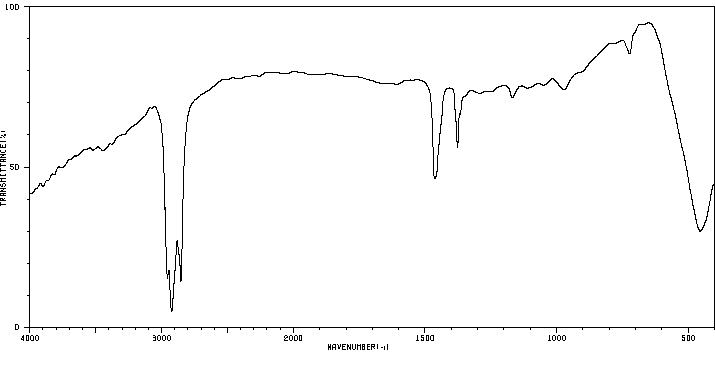氧化亚镍 | 1313-99-1
-
物化性质
-
计算性质
-
ADMET
-
安全信息
-
SDS
-
制备方法与用途
-
上下游信息
-
文献信息
-
表征谱图
-
同类化合物
-
相关功能分类
-
相关结构分类
物化性质
-
熔点:1960 °C
-
密度:6.67 g/mL at 25 °C(lit.)
-
溶解度:不溶于水;溶于酸溶液
-
暴露限值:a/nm
-
物理描述:Nickel oxide appears as odorless green-black cubic crystals (yellow when hot) or green powder. (NTP, 1992)
-
颜色/状态:Green powder
-
蒸汽压力:0 mm Hg at 68 °F (NTP, 1992)
-
分解:Toxic gases and vapors (such as nickel carbonyl) may be released ... in the decomp of nickel cmpd. /Nickel & sol nickel cmpd/
-
折光率:INDEX OF REFRACTION: 2.1818 (RED)
计算性质
-
辛醇/水分配系数(LogP):-0.12
-
重原子数:2
-
可旋转键数:0
-
环数:0.0
-
sp3杂化的碳原子比例:0.0
-
拓扑面积:17.1
-
氢给体数:0
-
氢受体数:1
ADMET
安全信息
-
TSCA:Yes
-
危险品标志:Xi,T
-
安全说明:S36/37,S45,S53,S61
-
危险类别码:R49,R43,R48/23,R36/37,R53
-
WGK Germany:1
-
海关编码:2825400000
-
危险品运输编号:UN 3288
-
RTECS号:QR8400000
-
包装等级:Z01
-
危险标志:GHS07,GHS08
-
危险性描述:H317,H350i,H372,H413
-
危险性防范说明:P201,P280,P308 + P313
SDS
制备方法与用途
氧化镍是一种p型半导体材料,禁带宽度为3.7eV,在传统工业中常用作光催化剂、镍铁电池阴极材料等。此外,它还用作陶瓷和玻璃的颜料,搪瓷工业中的瓷釉密着剂和着色剂,以及陶瓷工业中的色料原料。在磁性材料生产过程中,氧化镍常用于制造镍锌铁氧体。同时,它还可作为茶色玻璃和显像管玻壳的着色剂,也是制造镍盐及镍催化剂的重要原料。
制备方法一种制备氧化镍纳米晶体的方法如下:首先配置170mL摩尔浓度为0.12mol/L的NiCl2去离子水溶液;然后向该溶液中滴加77.5mL摩尔浓度为0.4mol/L的KOH的水/乙醇溶液,搅拌5分钟后离心提纯。将得到的绿色沉淀分散于200mL乙醇和二甲基亚砜(体积比1:1)混合液中,在150℃下反应3小时后经离心提纯获得氧化镍纳米晶体;再将其均匀分散在无水乙醇中,制得氧化镍纳米晶体(NiOx)的乙醇分散液。
毒性镍能进入细胞,破坏细胞中的酶和代谢过程,可能因生成某些致癌物质而产生致癌作用。接触镍盐可导致镍性湿疹或镍性疥疮。空气中二价镍氧化物最高容许浓度为0.5 mg/m³(以镍计)。在生产过程中操作人员需佩戴防毒口罩及面具,尽量避免皮肤直接接触,并实行机械化操作以减少粉尘。定期检查接触镍化合物的工作人员的身体状况。
化学性质常温下,氧化镍呈绿色至黑绿色立方晶系粉末,在高温下会变黄色。其相对密度为6.67,熔点为1984℃。氧化镍能溶于酸和氨水,而不溶于水或液氨。加热到400℃时,因吸收空气中的氧而转变为三氧化二镍;在600℃下还原为一氧化镍。低温制得的一氧化镍具有较高的化学活性,在1000℃高温煅烧下则变得较为稳定且活性较小。随着制备温度的升高,其密度和电阻增加,溶解度和催化活性降低。
用途氧化镍广泛应用于搪瓷、陶瓷及玻璃的颜料;磁性材料生产中用于制造镍锌铁氧体等;作为制造镍盐原料、镍催化剂,并在冶金与显像管行业中应用。此外,它还被用作电子元件材料、蓄电池材料,以及还原镍制备中的重要成分。
生产方法通过煅烧分解法将镍合金下脚料(含铁、铜、铬等杂质)经硫化氢、双氧水、碳酸钠和氨水处理去除杂质后,再与硫酸反应生成硫酸镍铵。随后经过焙烧粉碎步骤制得一氧化镍成品。反应方程式为:(NH4)2Ni(SO4)2 → NiO + SO3 + (NH4)HSO4 + NH3
反应信息
-
作为反应物:参考文献:名称:MATSUNO, XIROSI;SAGO, FUMIO摘要:DOI:
-
作为产物:描述:参考文献:名称:UEHDA, XISASI;JONEHMURA, MITIKO;SEHKINO, TADAO摘要:DOI:
-
作为试剂:参考文献:名称:Glycothermally Synthesized Self-aggregated ZnS Spherical Particles for Methyl Orange Photodecomposition摘要:以乙二醇(C2H6O2)为溶剂,通过糖热法在 125 oC 的相对低温下合成了高产率的 ZnS 粒子。我们报告了一种从 ZnS 纳米晶体制备球形自团聚 ZnS 粒子的简便方法,该方法以醋酸锌为 Zn2+ 源,硫脲为硫源,无需矿化或其他介质。利用 XRD、FE-SEM、TEM、XPS、BET 和紫外-可见吸收对自团聚 ZnS 粒子的晶相结构、形貌、尺寸、表面化学成分和光学性质进行了表征。ZnS 颗粒具有立方相锌混合物结构,不含任何其他杂质。根据 XRD 峰宽和 TEM 图像估算,合成的原生纳米晶体的平均晶粒大小接近 4 纳米。FE-SEM 图像显示,所有的 ZnS 都由自聚集颗粒组成,具有球形形态,大小约为 0.2 µm 至 0.5 µm,其中包含许多微小的原生纳米晶体。制备的 ZnS 在紫外区具有很强的光吸收能力。随着糖热反应温度的升高,光带隙从 3.85 eV 减小到 3.62 eV,这是由于粒度和结晶度的改善所致。通过在紫外光(λ = 365 nm)下光分解甲基橙(MO)染料,研究了糖热反应温度对合成的自团聚 ZnS 粒子光催化活性的影响。所制备的 ZnS 在照射 60 分钟后表现出优异的光催化降解性能,反应温度分别为 125 oC(5%)、150 oC(10%)、175 oC(60%)和 200 oC(90%)。研究发现,在 200 oC 下制备的 ZnS 粒子的光催化降解率最高,90 分钟后,各种光生自由基清除剂对 MO 的分解率接近 100%。DOI:10.3365/kjmm.2021.59.10.745
文献信息
-
The spectrum of nickel monoxide between 410 and 510 nm: laser-induced fluorescence and dispersed fluorescence measurements作者:Walter J Balfour、Jianying Cao、Roy H Jensen、Runhua LiDOI:10.1016/j.cplett.2003.12.089日期:2004.2and NO have been studied via laser-induced and dispersed fluorescence spectroscopies. NiC, NiH and NiO species have been detected between 410 and 510 nm. Twenty NiO bands have been rotationally analyzed for the first time and, in most instances, measurements of the 58NiO/60NiO isotopic shifts have been made. Dispersed fluorescence data have been collected at two excitation wavelengths, corresponding
-
Fourier transform infrared emission spectroscopy of a new A3Πi-X3Σ− system of NiO作者:R.S. Ram、P.F. BernathDOI:10.1016/0022-2852(92)90520-x日期:1992.10Abstract A new A3Πi-X3Σ− electronic transition of NiO has been observed in the near infrared region extending from 2.1 to 2.6 μm. The molecule was excited in emission from an Ni hollow cathode discharge and the spectra were observed using a Fourier transform spectrometer. The observed spectrum consists of the 0-0 band for the 3Π0-3Σ1−, 3Π1-3Σ0− subbands and the 1-1 band of the 3Π1-3Σ0− subband. The摘要 在从 2.1 到 2.6 μm 的近红外区域观察到了 NiO 新的 A3Πi-X3Σ− 电子跃迁。该分子在镍空心阴极放电的发射中被激发,并使用傅立叶变换光谱仪观察光谱。观察到的频谱由 3Π0-3Σ1−、3Π1-3Σ0− 子带的 0-0 波段和 3Π1-3Σ0− 子带的 1-1 波段组成。未观察到涉及 3Π2 自旋分量的子带。已经确定了包括激发态 A3Πi 中的 Λ 倍增常数在内的分子常数。从该分析中获得的新激发态的主要常数为 T0 = 4337.5554(12) cm-1、A0 = -283.3713(16) cm-1 和 B0 = 0.494659(11) cm-1。
-
Park; Hauge; Margrave, High temperature science, 1988, vol. 25, # 1, p. 1 - 15作者:Park、Hauge、MargraveDOI:——日期:——
-
TOYAMA, SIGEHKI;NAKAMURA, MASAAKI, KEHMIKARU EHNDZINIYARINGU, 33,(1988) N, S. 130-135作者:TOYAMA, SIGEHKI、NAKAMURA, MASAAKIDOI:——日期:——
-
BON, CHARLES K.;KNOWLES, VERA M.作者:BON, CHARLES K.、KNOWLES, VERA M.DOI:——日期:——
表征谱图
-
氢谱1HNMR
-
质谱MS
-
碳谱13CNMR
-
红外IR
-
拉曼Raman
-
峰位数据
-
峰位匹配
-
表征信息







